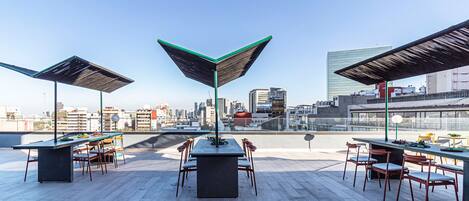Summary:
Each apartment has an open plan living/dining room with a fully equipped kitchen: Stove, sink, mixer taps, hood, porcelain floor, doors, white cabinets and granite countertops.
The apartments are oriented towards wide views of the city and the volcanoes, creating an ideal atmosphere to live and work in harmony.
They are completely equipped and have; First level finishes, generous heights, Spaces with natural lighting, large windows & large terraces
The Space:
Each apartment has an open plan living/dining room with a fully equipped kitchen: Stove, sink, mixer taps, hood, porcelain floor, doors, white cabinets and granite countertops.
The apartments are oriented towards wide views of the city and the volcanoes, creating an ideal atmosphere to live and work in harmony.
They are completely equipped and have; First level finishes, generous heights, Spaces with natural lighting, large windows & large terraces
Guest Access:
The amenities allow you to be highly productive and enjoy your moments of rest to the fullest in a safe environment.
Two patios with natural vegetation
Gym
Library
common roof garden
dining terrace
business center
24 hour surveillance
2 elevators
2 Covered Parking Spots
Visitor Parking
The Neighborhood:
The Mantik Céfiro 5 building has a privileged location south of CDMX, a few steps from the University City and the Science Museum, and four blocks from the Periferico.
Coyoacán (US: /ˌkɔɪoʊəˈkɑːn/ KOY-oh-ə-KAHN,[4][5] Spanish: [koʝoaˈkan] (listen)) is a borough (demarcación territorial) in Mexico City. The former village is now the borough's "historic center". The name comes from Nahuatl and most likely means "place of coyotes", when the Aztecs named a pre-Hispanic village on the southern shore of Lake Texcoco dominated by the Tepanec people. Against Aztec domination, these people welcomed Hernán Cortés and the Spanish, who used the area as a headquarters during the Spanish conquest of the Aztec Empire and made it the first capital of New Spain between 1521 and 1523.
The village and later municipality of Coyoacán remained completely independent of Mexico City through the colonial period into the 19th century. In 1857, the area was incorporated into the then Federal District when this district was expanded. In 1928, the borough was created when the Federal District was divided into sixteen boroughs. The urban sprawl of Mexico City reached the borough in the mid-20th century, turning farms, former lakes, and forests into developed areas, but many of the former villages have kept their original layouts, plazas, and narrow streets and have conserved structures built from the 16th to the early 20th centuries. This has made the borough of Coyoacán, especially its historic center, a popular place to visit on weekends.
Getting Around:
Getting Around Mexico City
The best way to get around Mexico City is via Uber or a taxi. The metro is another option. Not only is it fairly clean and quick, but you can ride for approximately $0.25. Plus, most popular tourist attractions are easily accessible by train. Several different types of buses motor through the main square (el Zócalo) and its busiest streets – they are also an affordable option.
Taxis are slightly more expensive, but they are a hassle-free means of getting to the city center from the Benito Juárez International Airport (MEX), which is about 6 miles east of the Centro Histórico. Uber is a safe and more affordable way to navigate the city. Driving yourself is not a great idea – either to and from the airport or around town.
Metrobús
Like the subway, Mexico City's Metrobús is a cheap, efficient and super-crowded way to move around town. These red and white buses move (quickly) in dedicated lanes along the Avenida de los Insurgentes. To ride you'll need to purchase a smartcard (available at vending machines in the Metro stations); the card will cost 16 pesos (or about $0.84) and rides cost 6 pesos one way (about $0.31). There have been some reports of inappropriate behavior and groping toward females on the metrobús; now there are also women-only buses – to ride one of those, wait at the designated platforms.
Metrobús
Tourist Bus
The red double-decker Turibus provides commentary (available in eight languages) on various popular sights and routes throughout the city. Tours usually last around three hours with approximately 20 stops along the way. For those looking to pack in lots of sightseeing in one day, it's an affordable option (costing about $8 for adults). It departs daily from 9 a.m. to 9 p.m. It's also among our best tours in Mexico City.
Turibus
ColectivosAlso known as microbuses or peseros, colectivos are privately run green and grayish-white buses that also run along major arteries like Avenida Juárez, Paseo de la Reforma and the Chapultepec Forest. Riding the Colectivo is marginally cheaper than the Metrobús, plus it will make many of the same stops. Cards in the windshield will alert you to the route, and drivers will normally hold up fingers when coming to a stop, to indicate how many empty seats there are inside.
Taxi or Uber
Phone ahead for a taxi de sitio to ensure that you get official and safe transportation around the city. Most hotels and restaurants are happy to call one of the official cars for you, or you could wait at the "Sitio" signs and stands located around town. (Flagging one down on the street could leave you in the potentially precarious situation of hopping in the back of an unofficial green VW taxi and a driver with maybe questionable intentions.) Additionally, Uber operates in Mexico City and is an affordable and safe way to navigate the metropolis.
Uber
Metro
The metro is cheap, clean and efficient, but you should keep in mind a few tips before your first ride. One, the first two cars of each train are for women and children only. Two, you should only carry small bags on your person – large bags mark you as a tourist, and suitcases are not permitted at all. Three, the metro is very crowded during the morning and evening rush hours, and that's also when it's more prone to pickpockets. Tickets cost 5 pesos, or a little more than $0.25.
Metro de la Ciudad de México
Car
Driving yourself is ill-advised. The streets are congested, the routes are baffling, parking is scarce and expensive, plus the rules of the road are hard to understand (particularly since drivers rarely follow them). In some areas, there's also a danger of auto theft. If you do decide to drive, you do not need to obtain an international driving permit; your U.S. driver's license is valid. Several car rental companies operate out of the Mexico City airport.
Other Things to Note:
You will be in one of the biggest cities in the world, it can get hectic and messy. We do our best to provide a calm and peaceful stay, however, please consider there may be noise coming from outside.
Interaction with Guests:
The Capitalia team will always be on the lookout for you and for anything and/or doubts you have before, during and after your stay. We will be available to you by phone or message and in some cases you can find us at the Administration of the residential, as well as our security team that are available 24/7 , they can support you In your doubts or requirements.















